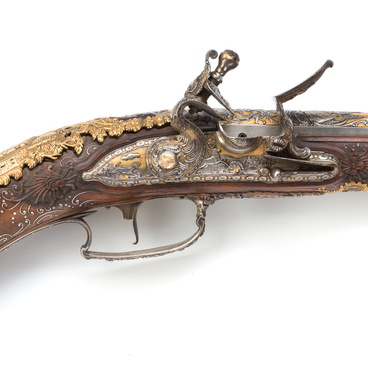The wheellock gun made in the 1560–1570s is one of the oldest exhibits of the Gatchina Museum weapons collection. It has neither marks nor signatures so it is impossible to attribute the gun. However, some elements of construction and decoration are typical for Germany. Metal parts of the gun are blued and have no decorations, but all the surface of the stock is inlaid with engraved bone inserts in the form of lions, monkeys, centaurs and other mythical creatures on the background of a stylised floral pattern. The gun is fitted with the so called wheellock — a mechanism which creates a spark to ignite the gunpowder in the barrel. The name of the mechanism comes from the main part of the lock — a grooved wheel. A piece of flint or pyrite is clamped in the jaws on a spring-loaded arm or ‘dog’. Before a shot the pyrite comes in contact with the grooved wheel. When the trigger is pulled, the wheel begins moving and its friction against the pyrite generates intense sparks, which ignite a small portion of gunpowder in a pan. The gunpowder flashes through a small touch hole to ignite the main charge in the barrel thus making a shot. The wheel is rotated by a spring which is tensioned by a spanner (or wrench) before the shot. Such locks were heavy and their construction was very complex for that time. Wheellocks were costly and demanded good maintenance. However, on the territory of Germany and countries with similar culture (first of all in Czechia and Austria) this type of locks was very popular and remained in use longer than in other countries. Even when a simpler, cheaper and more reliable flintlock mechanism became wide spread in other countries of Europe, in Germany hunters interested in precision shooting still gave preference to wheellocks. Stocks of German guns of that time look unusual today. They are almost straight with heavy buttstocks of complex shapes. The butt is cut at an angle and often ends with a ball, which makes it impossible to mount the gun to the shoulder and aim in the same manner as it is done now. But such guns were not held against the shoulder. They were held a bit higher, with the cheek pressed tightly against the left side of the stock. Since the barrels of German guns were heavy, they compensated the recoil so there was no need to mount the gun to the shoulder. The ball at the butt of the stock was meant for additional protection when the gun was put on the ground. This shooting position was popular among commercial hunters in Russia until the 19th century.
№1 Wheellock gun
Creation period
1560–1570s
Place of сreation
Germany
Dimensions
overall length — 122.5 cm, barrel length — 97.1 cm, calibre — 19 mm
Technique
forging, bluing, casting, wood and bone carving, engraving, inlay
Collection
0
Open in app#1
№1 Wheellock gun
#3
#4
Ministry of Culture of the Russian Federation
read morehide
00:00
00:00
1x
№1 Wheellock gun
Creation period
1560–1570s
Place of сreation
Germany
Dimensions
overall length — 122.5 cm, barrel length — 97.1 cm, calibre — 19 mm
Technique
forging, bluing, casting, wood and bone carving, engraving, inlay
Collection
0
Open in app
Share



